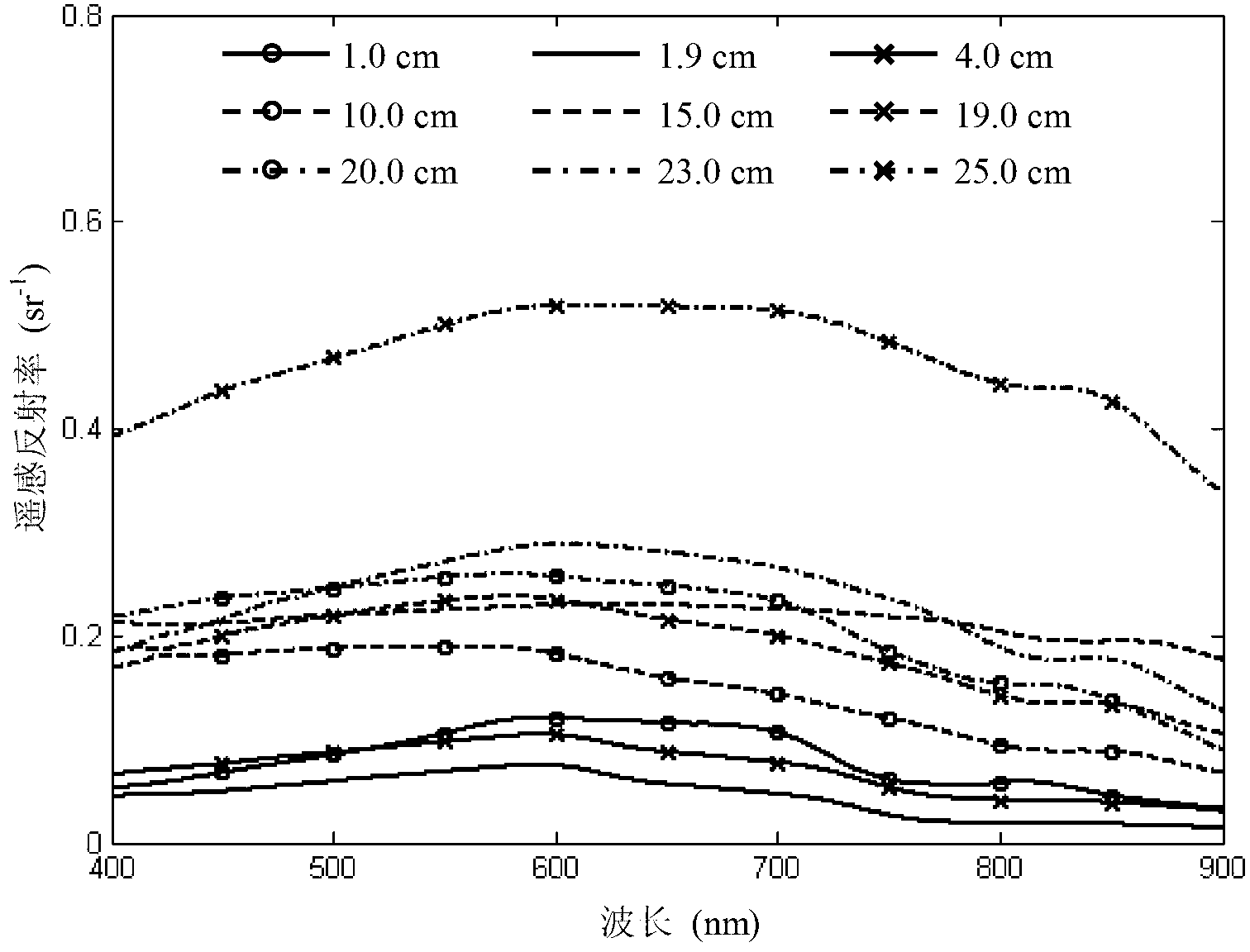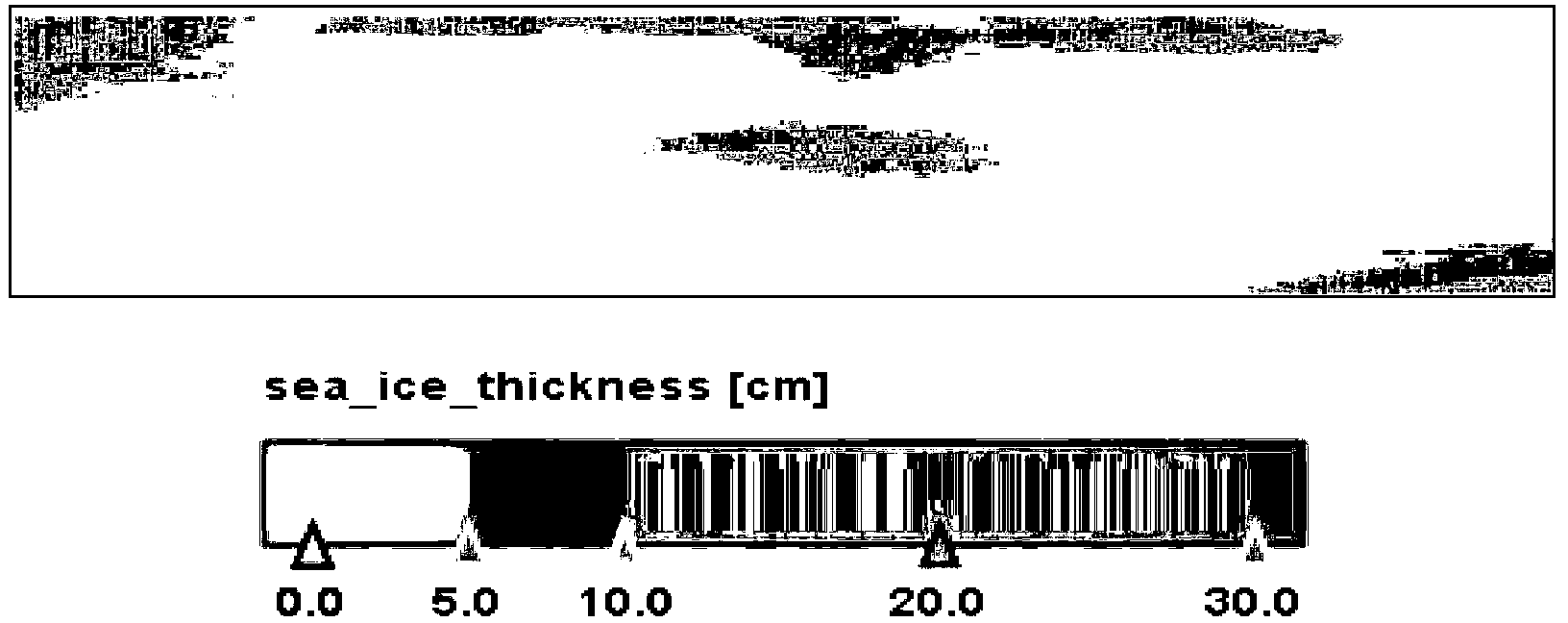Method for calculating sea ice thickness based on hyperspectral remote sensing reflectance
A technology of remote sensing reflectance and hyperspectral remote sensing, applied in the field of sea ice thickness calculation, can solve the problems of low time and space resolution, affecting the calculation and monitoring of sea ice thickness, and achieve the effect of simple method
- Summary
- Abstract
- Description
- Claims
- Application Information
AI Technical Summary
Problems solved by technology
Method used
Image
Examples
Embodiment 1
[0030] The sea ice thickness is calculated by using the remote sensing reflectance obtained from the on-site measurement of natural sea ice by ground object spectrometer. The measured thickness of sea ice is 1.0cm, 1.9cm, 4.0cm, 9.5cm, 10.0cm, 15.0cm, 19.0cm, 20.0cm, 23.0cm, 25.0cm.
[0031] From the hyperspectral remote sensing reflectance spectrum of sea ice, the remote sensing reflectance with wavelengths of 572nm, 585nm, 702nm, 744nm and 880nm is selected, and the calculated sea ice thickness is shown in the table below.
[0032] Measured value (cm)
Calculated value (cm)
Absolute error(cm)
Relative error(%)
1.0
1.0
0.0
0.00
1.0
1.4
0.4
40.00
1.9
1.7
0.2
10.53
1.9
1.4
0.5
26.32
4.0
4.9
0.9
22.50
4.0
4.7
0.7
17.50
9.5
12.4
2.9
30.53
9.5
13.8
4.3
45.26
10.0
8.6
1.4
14.00
15.0
...
Embodiment 2
[0040] For the sea ice frozen under laboratory conditions, the remote sensing reflectance data is obtained by measuring the surface object spectrometer, and the thickness is calculated. The measured thickness of sea ice is 6.5cm, 10.0cm, 20.0cm and 32.0cm, respectively.
[0041] From the remote sensing reflectance spectrum of sea ice, select the remote sensing reflectance with wavelengths of 572nm, 585nm, 702nm, 744nm and 880nm, and substitute them into the sea ice thickness calculation model to calculate the thickness of sea ice.
[0042] Measured value (cm)
[0043] After testing, the correlation coefficient R between the measured value of sea ice thickness and the calculated value of the model 2 =0.97, average relative error APD=28.7%, root mean square error RMS=3.3cm, less than 4.0cm.
Embodiment 3
[0045] Using aerial hyperspectral images of sea ice in Liaodong Bay in winter (such as figure 2 ) to calculate sea ice thickness. First calculate the digital quantization value of the original image If it is less than 3.54, the sea ice pixel is identified; then geometric correction, radiation correction and atmospheric correction are performed on the aerial hyperspectral image to obtain the remote sensing reflectance; The albedo is substituted into the calculation model of sea ice thickness, and the calculated spatial distribution of sea ice thickness is shown in image 3 , the distribution range of ice thickness is 1.0~25.0cm, and the calculated results are reasonable.
[0046] In summary, the present invention uses on-site and laboratory-measured sea ice hyperspectral data to calculate sea ice thickness, and its root mean square error is within 4.0cm; using aerial hyperspectral images to calculate sea ice thickness, the calculated The result is reasonable.
PUM
 Login to View More
Login to View More Abstract
Description
Claims
Application Information
 Login to View More
Login to View More - R&D
- Intellectual Property
- Life Sciences
- Materials
- Tech Scout
- Unparalleled Data Quality
- Higher Quality Content
- 60% Fewer Hallucinations
Browse by: Latest US Patents, China's latest patents, Technical Efficacy Thesaurus, Application Domain, Technology Topic, Popular Technical Reports.
© 2025 PatSnap. All rights reserved.Legal|Privacy policy|Modern Slavery Act Transparency Statement|Sitemap|About US| Contact US: help@patsnap.com



